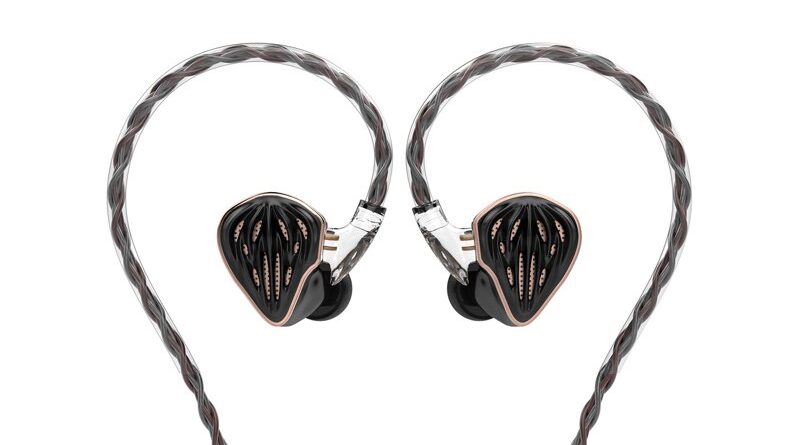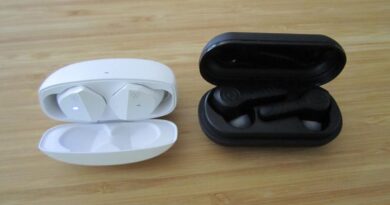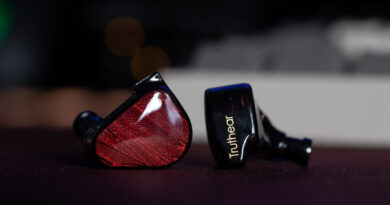Hidizs MS5 Review (2) – It’s A Long Way To The Top
As some of my 18 readers may recall I am kinda impervious to hype and quite inelastic on sidegrading. It’s with such unchanging mind that I approached the assessment of the hype of the day – Hidizs’ new take to the mid-tier IEM market.
These MS5 have been heavily anticipated and are supported by a very energetic marketing campaign (nice job there, it must be said). Priced at $499 List, they are currently on promo at $399 + freight, and you can buy them here.
(As always our links are not sponsored: we don’t get any commission on sales – we “literally” don’t “care” if anyone buys anything as a consequence to any of our articles).
In this Article
At-a-glance Card
| PROs | CONs |
| Good tonal balance. | Lean, somewhat artificial timbre. |
| Good bass, both snappy and rumbly. | Unrefined, thin, often messy trebles. |
| Good imaging. | Lean-ish mids. |
| Good / very good instrument separation. | Flat stage. |
| Not inexpensive. |
Full Device Card
Test setup and preliminary notes
Sources: Questyle QP1R & QP2R / Sony NW-A55 mrWalkman / Questyle M15 / Questyle CMA-400i – JVC Spiraldot tips – Stock cable – lossless 16-24/44.1-192 FLAC and DSD64/128 tracks.
I am not writing these articles to help manufacturers promote their products, even less I’m expecting or even accepting compensation when I do. I’m writing exclusively to share my fun – and sometimes my disappointment – about gear that I happen to buy, borrow or somehow receive for audition.
Another crucial fact to note is that I have very sided and circumscribed musical tastes: I almost exclusively listen to jazz, and even more particularly to the strains of post bop, modal, hard bop and avangarde which developed from the late ’50ies to the late ’70ies. In audio-related terms this implies that I mostly listen to musical situations featuring small or even very small groups playing acoustic instruments, on not big stages.
One of the first direct consequences of the above is that you should not expect me to provide broad information about how a certain product fairs with many different musical genres. Oppositely, you should always keep in mind that – different gear treating digital and analog sound in different ways – my evaluations may not, in full or in part, be applicable to your preferred music genre.
Another consequece is that I build my digital library by painstakingly cherrypick editions offering the least possible compression and pumped loudness, and the most extended dynamic range. This alone, by the way, makes common music streaming services pretty much useless for me, as they offer almost exclusively the polar opposite. And again by the way, quite a few of the editions in my library are monoaural.
Additionally: my library includes a significant number of unedited, very high sample rate redigitisations of vinyl or openreel tape editions, either dating back to the original day or more recently reissued under specialised labels e.g. Blue Note Tone Poet, Music Matters, Esoteric Jp, Analogue Productions, Impulse! Originals, and such. Oppositely, I could ever find and extremely small number of audible (for my preferences) SACD editions.
My source gear is correspondigly selected to grant very extended bandwidth, high reconstruction proweness, uncolored amping.
And finally, my preferred drivers (ear or headphones) are first and foremost supposed to feature solid note-body timbre, and an as magically centered compromise between fine detail, articulated texturing and microdynamics as their designers can possibly achieve.
In terms of presentation, for IEMs I prefer one in the shape of a DF curve, with some very moderate extra pushup in the midbass. Extra sub-bass enhancement is totally optional, and solely welcome if seriously well controlled. Last octave treble is also welcome from whomever is really able to turn that into further spatial drawing upgrade, all others please abstain.
Signature analysis
Tonality
MS5 come with a modular screw-in nozzle system intended to offer easy access to tuning alternatives.
Default nozzles are colored “Gold” and are supposed to offer the most balanced presentation – whatever that means in the manufacturer’s mind.
Red nozzles are supposed to offer a bassier alternative, and they do, but just indirectly: they mainly tame trebles between 3KHz and 5KHz, and quite substantially so, while leaving the bass line pretty much unaltered in elevation, just a bit tamed in terms of transients.
Lastly, Silver nozzles are supposed to offer a brighter, more treble-accented presentation, which they indeed do – even too much so.
Which one to choose?
Let’s start from noting that on Gold nozzles MS5 offer a “reasonably” coherent presentation. The Dynamic Driver in charge of the bass is well harmonized with the BA also in charge of the same segment, and that’s very good. Not the very same however happens when we consider the 2 BAs in charge of the trebles. The end result is decent in terms of timbre homogeneity but not much more than that: MS5’s timbre is on average lean-ish, a bit better bodied towards the bass, and oppositely quite anemic towards the treble. The general tonality is bright although not excessively so (treble exaggerations are a separate discussion, see below).
So much for Gold nozzles. As trebles are MS5’s most prominent Achille’s heel (again, see below), Silver nozzles furtherly enhancing treble are a quite obvious no-no. I guess that will stand for die-hard treble heads too, however personal tastes are sacred of course, so…
Red nozzles sound (pun intended) like a viable alternative to Gold ones: they change the general timbre making it “woolier”, and make tonality much less bright, mure like “bright-neutral” indeed, but the presentation gets definitely duller.
Long story short, MS5’s nozzles remind me a “pick your poison” scenario: Gold nozzles for a bright tonality on overly thin timbre. Red nozzles for a less thin, less bright but also less engaging experience. Silver nozzles… just bin them. In the end I “preferred” the Gold poison option, which is then what all the following notes refer to unless, where explicitly otherwise indicated.
Sub-Bass
Rumble is very present and not excessive, thanks to the good deeds of the Dynamic Driver
Mid Bass
The midbass is arguably the best part of the product. Here a very good job has been made in making the BA and the DD drivers work together coherently, resulting in mid bass notes which are at the same time snappy, punchy, textured and bodied. No overshadowing of the mids ever takes place, and a correct balance is also kept vis-a-vis the sub bass rumble.
On Red nozzles the entire timbre gets a perceivable bit less sharp, more “wooly” so to say, which files off some of the bass thumpness. Not wonderful but not a tragedy either.
Mids
Mid frequencies are uninspiring, mainly due to a definitely lean timbre making them lack body and credibility. They are clean, and that’s a plus of course, but highmids tend to be often too prominent, and sibilant in many occasions.
On Red nozzles the tonality situation gets sensibly better, whereby mids come across a bit (not much) more bodied and natural, and highmids cease being sibilant and excessive in most occasions, however clarity gets a severe hit.
Male Vocals
Male voices partially benefit from the good deeds of the low-range BA (and possibly of the DD too?) so in terms of tone they come across as reasonably organic more often then not. Microdynamics are however basic if even present, and texturing is meh.
Red nozzles make them a bit better, if a tad softer.
Female Vocals
MS5 is not the driver you want for female voices, that’s clear as the sun in the sky. Too lean, even ethereal, very often sibilant, and totally inorganic. Red nozzles make them less tragic, almost viable.
Highs
Trebles are a mixed bag of very diverse stuff. On one end there’s some good energy, a lot of detail, and a lot of speed. On the flip side there’s way too thin body, and a sharp and frequent tendence to get unresolving and even messy, screwing layering and in the worst cases imaging too.
On Red nozzles the situation gets miles better, thanks to a quite dramatic taming of the frequencies between 3 and 5 KHz. Imaging comes out much more organic and credible, and that’s another plus. The downside however is that the positive energy is almost entirely gone, and Red-tamed trebles make the entire MS5 presentation much more “ordinary”, almost “dull” – a true pity.
Technicalities
Soundstage
Soundstage projection is not more than average for this price class, mainly focusing on horizontal and vertical axes, and hardly any depth.
Imaging
Macrodynamics (imaging) are not bad in general on MS5, and they would be even very good if it weren’t for the mids and most of all the trebles too often paddling in the wrong direction. Red nozzles make the situation better on this chapter.
Details
Detail retrieval is, together with bass, where MS5 show their best. Both bass and highmids+trebles do deliver tons of good details
Instrument separation
MS5’s proweness on detail retrival on one end turns into outstanding resolving power. The down side – very common on not particularly sophysticated BA-sets, and MS5 is not an exception – is a quite dramatic lack of microdynamics, mainly on the high registers. So MS5 offer very good instrument separation but at the high cost of too cut-out notes which is particulary detrimental on acoustic music of course.
Driveability
Thanks to their 104dB sensitivity MS5 are not difficult to drive, but beware their superlow impedance in case your source has an output impedance of 1 ohm or more – that might result in some unwanted midbass pushup
Physicals
Build
Housings are realised as a one-piece aluminum container, which appears at time solid and very elegant. Very stylish is the faceplate (its appreciation of course depends, even more then the rest, on personal tastes).
Fit
MS5 housings are quite bulky and they don’t sit properly into my concha: in spite of their quite long nozzles their shape and size are such that they keep protruding quite a bit towards the outside, which makes their firmness somewhat wonky.
MS5 also are quite tip sensitive, and (not uncommonly) none of the 3 different types of bundled tips are ideal for my tastes. After the usual long rolling session I decided that best match are JVC SpiralDots as they tend to tame the treble excesses while also offering a bit more tightness to the bass.
Comfort
Their shape and size make MS5 fit only “partial” as described above, which generates some light discomfort over medium wearing time for me
Isolation
Passive isolation is light, in my case mainly due to the housings not “filling” my concha appropriately
Cable
The stock cable is – like the housings – no doubt very nice to look at. Not the same I can say however in terms of practical use. Its creative 2-pin plugs can be annoying (they are in my case). The cable structure is very thick and wont be liked by those preferring smoothly flexible chords. Last but not least, I see no excuse at this date for offering a 499$ MSRP set (even if 25% discounted upon launch) bundled with a non-modular termination cable.
Specifications (declared)
| Housing | CNC 1 piece Aluminum Alloy Cavity + Resin Hollow Panel |
| Driver(s) | 1 x Hidizs New Custom Liquid Silicone Dynamic Driver, 4 x Denmark Sonion Balanced Armature Drivers |
| Connector | 2pin 0.78mm |
| Cable | Braided 8 strands 6N Single Crystal Copper Silver plated + 6N Single Crystal Copper wire, 1.2m long with 3.5mm fixed termination |
| Sensitivity | 104 dB/mW |
| Impedance | 5.3 Ω |
| Frequency Range | 20-40000Hz |
| Package and accessories | 3 pairs (S, M, L) white silicon tips recommended for Vocals, 3 pairs (S, M, L) white+black eartips recommended for Balanced sound, 3 pairs (S, M, L) black eartips recommended for Bass enhancement, 3 pairs of tuning nozzles (red: bass, silver: treble, gold: balanced), faux-leather carry case |
| Pricing at this post time | $379 launch price (expired), $399 current promo, $499 list |
Comparisons
Penon FAN2 ($280)
FAN2 offer an almost neutral presentation with a punchy bass emerging off of it without however warming it all up too much. The timbre is quite bodied although south of lushy – however miles more solid than MS5’s. Most of all, FAN2’s timbre is coerent across the entire spectrum, while MS5 is far from that target.
FAN2 bass is very good, punchy and somewhat rumbly, yet MS5 is better on both counts. Mids and moreover trebles are totally obviously better on FAN2 in terms of timbre, tonality, texture and organicity.
Detail retrieval is superior on MS5, microdynamics and layering are obviously much better on FAN2, which also leads in terms of imaging sharpness and realism. Neither is a monster at stage projection however FAN2 has much better distribution especially in the sense of depth.
Fearless S8F ($489)
S8F are a mid-tier full-BA set. Their main, probably single serious downside (a total turnoff for many, however – me included) is the unforgiving BA timbre and consequent scarcity on microdynamics, which is mostly common to MS5 however.
S8F tonality is well balanced, marginally even better than S8F. In spite of its above-mentioned “imperatively BA” nature, S8F timbre is anyhow less lean and most of all much more coherent compared to MS5’s. MS5 offer a better structured bass line. Vocals are better on S8F, females in particular. Detail retrieval is about on par on highmids and trebles with S8F sounding a bit better thanks the somewhat better control in the presence and brilliance sections. Soundstage is no biggie in both cases, S8F being less wide but a bit deeper.
Tanchjim Darling ($419)
Darling are based on 1 DD + 2 Sonion BA, in lieu of the 4 Sonions adopted inside MS5. Very simply put, Darling deliver correctly on pretty much everything MS5 fail on.
Darling’s tonality is bright-neutral, with a much more coherent and bodied, acoustic timbre compared to MS5. Darling bass and sub bass are extremely good, fast, punchy yet rumbly and textured – nothing worse than MS5. On Darling highmids and brilliance trebles are wonderfully cablibrated and deliver clarity, detail, sparkles and air while always avoiding fatigue – the polar opposite of what happens on MS5. Female vocals are very good and therefore much better on Darling, male vocals are just marginally better though.
Separation is probably on par on the two sets, but Darling win big on microdynamics and soundstage, and less big, but still have an edge, on imaging.
Final A5000 ($279)
A5000 represent a possibly even more significant comparison then even Darling are, as they deliver on many counts even better results than MS5 within a very similar bright-neutral base target tuning, all of that by employing just 1 (one) driver, and at a sensibly lower price.
A5000 first of all offer an almost impeccable timbre coherency accross all the spectrum. Their bass is similarly punchy, with even better texture but a bit less rumble compared to MS5. Low mids are somewhat recessed on A5000 and a bit lean too, however their timbre and note body is way more organic and natural-sounding that MS5’s.
Highmids and treble are superbly calibrated on A5000. Certainly detail retrieval is less articulated on A5000, but in exchange microdynamics are all there where they are supposed to be – within a fast driver category, surely – instead of MIA as on the MS5.
From the tonality standpoint a valid criticism on A5000 is that highmids are too enhanced compared to mids. What’s interesting here is that moderately pushing central mids (1 – 2KHz) up with a wide eq filter closes the gap on that transition, delivering a more balanced result free from excesses (shouts, splashes or zings). Not the same happens on MS5 when you try (via the Red nozzles or via EQ) to similarly rebalance: the result is a more fluid tonal transition, yes, but still accompanied by lack of refinement both on the highmids & trebles, and on the lowmids & midbass (read more above).
Instrument separation sounds more detailed on MS5, but much more enjoyable on A5000 thanks to the less arid timbre, and better microdynamics.
Considerations & conclusions
As I tried to outline, I found MS5 a more than acceptable product, presented in a quite elegant and rich way too. Bass, detail retrieval and instrument separation are surely commendable, so is the adoption of replaceable nozzles to offer pre-defined “tuning variations” to the more curious users.
The timbre, however, is off, both in nature and coherence. Note body is too lean, trebles can obviously use more work upon, so do soundstage projection and microdynamics.
In conclusion MS5 are not disdainable at all, however they don’t seem yet to have what it takes to stand out of their existing competition, sometimes even costing significantly less.
Based on the very plesant communication I’m having with them I can testify Hidizs sounds strongly committed on their IEM program, for which they of course aim at the same market recognition they deservedly conquered on the budget DAP segment. I’m very sure they will come up with better and better proposals on the IEM market too in the near future. Let’s stay tuned 🙂
Our generic standard disclaimer.







